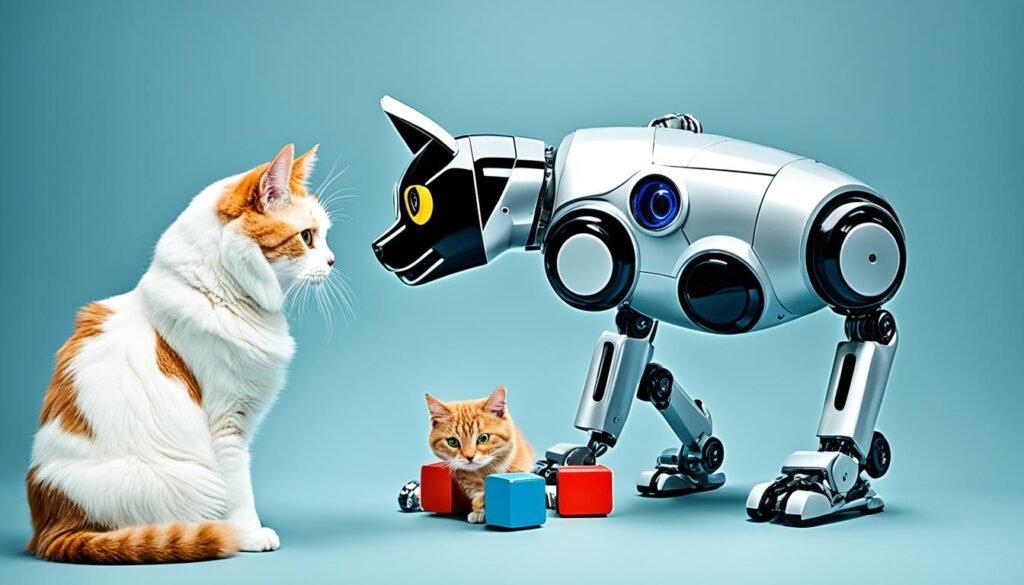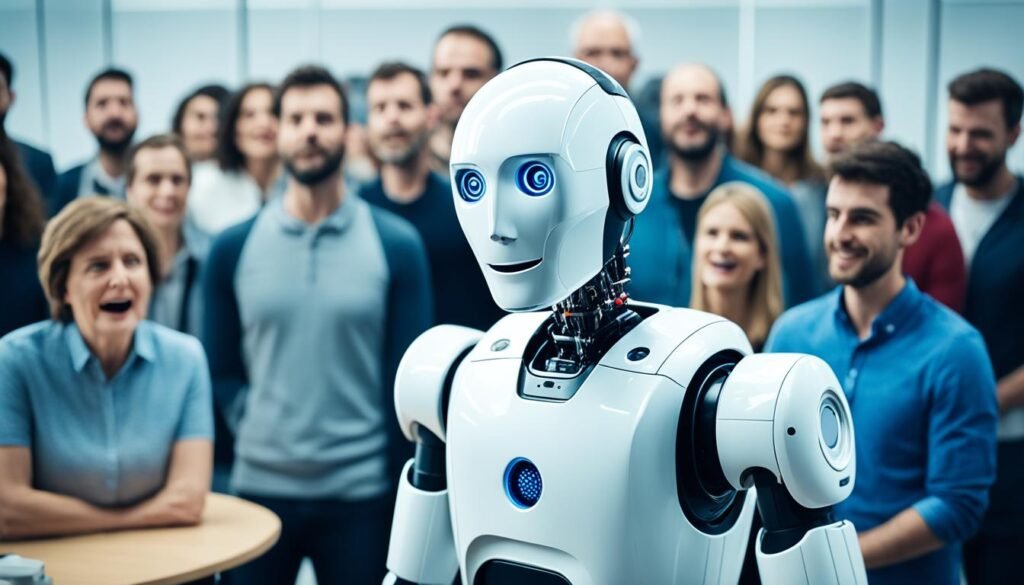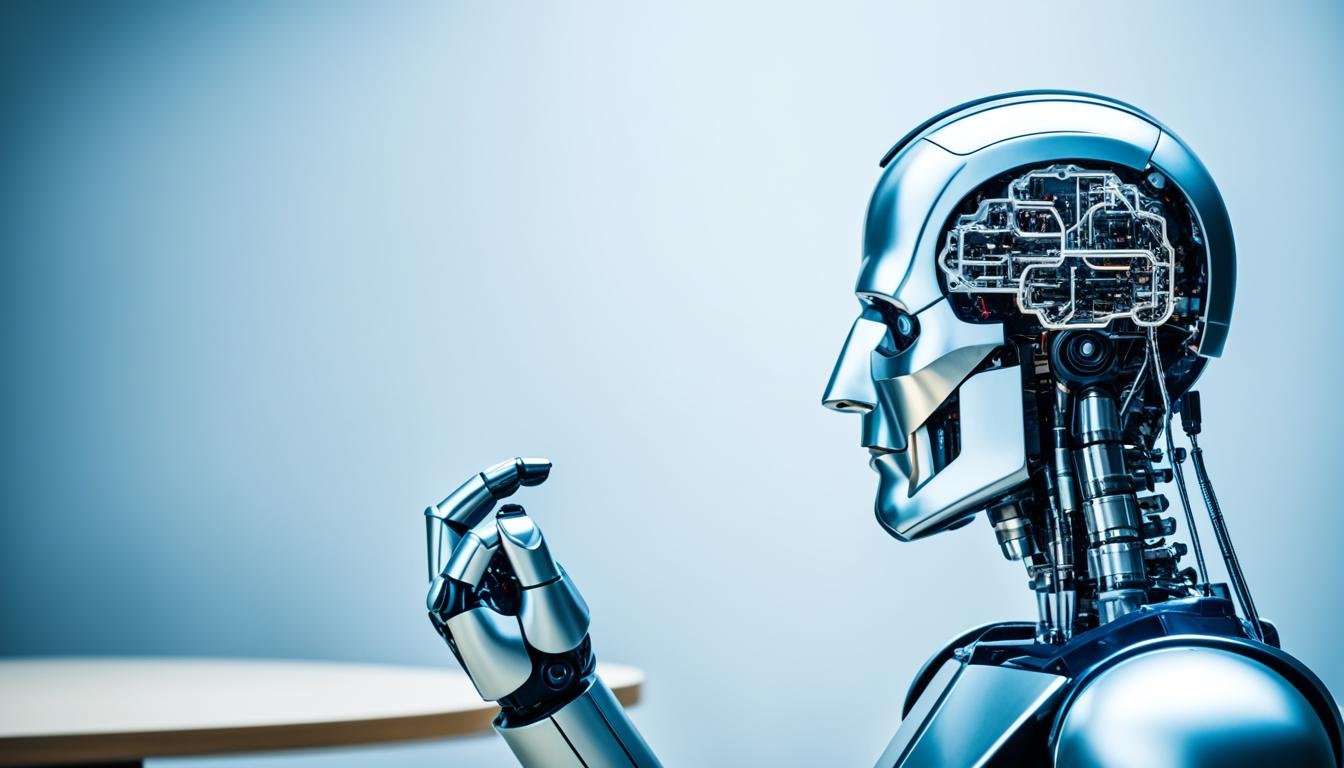In June 2024, a UK cinema had to cancel an AI-written film after people complained it wasn’t made by a human. This shows us that even though AI has changed our world a lot, it’s not perfect. Knowing where AI can’t do well is key.
AI has many limits, like not understanding context well and lacking common sense. It can also be biased and not creative or emotional. This article will talk about the main limits of AI. It aims to help you understand this fast-changing tech better.
Key Takeaways
- AI systems struggle with nuances, subtleties, and cultural references, often failing to grasp the full context of a situation.
- Lack of common sense and inability to apply knowledge flexibly make AI prone to errors in novel situations.
- Biases present in AI systems can lead to discriminatory and unethical outcomes, necessitating careful oversight.
- AI lacks the creativity and emotional intelligence that humans possess, limiting its ability to generate truly novel ideas or experiences.
- Transparency and interpretability issues with AI decision-making processes raise concerns about accountability and trust.
AI’s Limited Understanding of Context
AI has made big leaps in recognizing patterns, analyzing data, and predicting outcomes. But, it often finds human language and communication tricky. AI’s limited understanding of context makes it hard to grasp the depth of real-world interactions.
Struggles with Nuances and Subtleties
AI looks at huge amounts of data to spot patterns and make predictions. Yet, it misses the deeper understanding of human behavior, social dynamics, and cultural references. This means AI might not get sarcasm, irony, or figurative language right, leading to wrong or odd answers.
Difficulty Understanding Idioms and Cultural References
Idioms and cultural references are tough for AI. They’re tied to the historical, social, and cultural context of a language. Without getting these, AI can’t understand and reply to language correctly, causing communication problems.
The AI’s contextual awareness issues affect many areas, like natural language processing and conversational AI. As AI gets better, we need to improve its contextual understanding. This will involve progress in machine learning, cognitive science, and how humans and computers interact.
“AI systems can recognize patterns in data, but they struggle to truly understand the deeper meaning and context behind those patterns.”
Working on AI’s limited understanding of context will open up new ways for AI to work with human intelligence. This could lead to more natural and effective interactions.
Lack of Common Sense
Artificial intelligence (AI) has made huge strides, but it still lacks common sense. AI systems find it hard to use their knowledge in new situations. This makes them prone to errors. It’s a big challenge for AI to make important decisions on its own.
Inability to Apply Knowledge Flexibly
AI depends a lot on the data it’s trained on. It can only make decisions based on that data. This means it can’t adapt well to new situations. Unlike humans, AI can’t use a wide range of knowledge to solve problems creatively.
Prone to Errors in Novel Situations
When AI faces new situations, it often makes mistakes. For instance, an AI trained to recognize objects might not know a new one. This makes it need human help to learn again. Such errors can lead to AI making silly or dangerous choices, which hurts trust in the technology.
| Statistic | Insight |
|---|---|
| More than 20 USC researchers reported on technical reasons for AI’s lack of common sense at the USC AI Futures Symposium on AI with Common Sense. | Researchers are actively investigating the technical challenges in developing common sense reasoning in AI systems. |
| In a sample case where an AI system was tasked to write a professional biography, it incorrectly stated that the individual had passed away the previous year, demonstrating a lack of common sense. | AI systems can produce nonsensical outputs due to their inability to apply common sense knowledge, undermining their reliability. |
| A comparison was made between IBM’s supercomputer “Watson” participating in Jeopardy in 2011, performing impressively but still producing ridiculous answers years later, highlighting the ongoing issue of common sense in AI. | Even highly advanced AI systems continue to struggle with common sense reasoning, indicating the persistence of this challenge in the field. |
The challenge of common sense in AI is big, but researchers are working hard to fix it. They’re combining AI with social sciences and trying new methods. This could help make AI more like us, leading to more reliable AI systems.

Bias in AI Systems
Artificial Intelligence (AI) has a lot of potential but isn’t free from the biases in the data it uses. AI bias, or the way it keeps and boosts existing biases, is a big worry as these technologies get more common in our lives. These biases can come from different parts, like how the data is collected and labeled, and how the models are trained and used.
Selection bias is a big problem, where the data used to train AI doesn’t truly show the reality it’s trying to mimic. This can make AI systems less accurate for certain groups, leading to unfair and unjust decisions. These decisions can have big effects on people and society.
Another issue is confirmation bias, where AI systems stick too much to what they already know, possibly making harmful stereotypes worse. For example, facial recognition systems are often less precise for people with darker skin, which keeps AI discrimination going.
It’s important to tackle bias in AI to make sure these technologies are fair and ethical. Here are some ways to do it:
- Diversifying the training data to include more groups
- Checking AI systems for biases at every stage
- Using strong AI governance to make things clear and accountable
- Adding human oversight and a “human touch” in decision-making
As AI becomes a bigger part of our lives, we need to face the issue of biased AI systems directly. By doing so, we can use AI to make the world more fair and just.
| Type of Bias | Description | Example |
|---|---|---|
| Selection Bias | Training data doesn’t accurately represent reality | Biased sampling or incomplete datasets |
| Confirmation Bias | AI relies too heavily on existing data trends, reinforcing stereotypes | Facial recognition algorithms being less accurate for people of color |
| Measurement Bias | Collected data systematically differs from actual variables of interest | Predicting student success using only data from course completers |
| Stereotyping Bias | AI perpetuates harmful stereotypes | AI systems exhibiting gender bias in job ads |
| Out-group Homogeneity Bias | Misclassification of individuals not part of the majority group | Lower accuracy for minority groups in computer-aided diagnosis systems |
where ai fails
Artificial intelligence (AI) is getting better all the time, but it’s key to know its limits and where it can fail. AI has done great things in many areas. Yet, there are times when it shows its limits and makes mistakes.
Air Canada had a problem with its virtual assistant. It gave wrong info, making a passenger pay CA$812.02. This shows AI can miss the point of what customers are asking for.
Sports Illustrated used AI to write articles, but they were taken down because they were not good enough. Gannett, a big newspaper publisher, stopped using an AI tool called LedeAI. This was because the articles it made were too repetitive and not up to standard.
AI in hiring has also had its issues. iTutor Group had to pay $365,000 to settle a lawsuit. This was because its AI software unfairly treated older job applicants.
Zillow’s ML algorithm, used in its Zillow Offers home-flipping program, had a median error rate of 1.9%. This led to wrong home price predictions and big job cuts.
These examples show how AI can cause big problems. From money losses to damage to a company’s reputation and ethical issues. It’s important to understand what AI can’t do as it gets more common in our lives.

As AI gets better, we need to keep a close watch on its limits. Knowing when AI fails helps us deal with its risks and challenges. This way, we can use AI in a smarter and more careful way.
Lack of Creativity
AI has made huge strides, but it can’t quite match human creativity yet. It’s limited by the algorithms and models that run it. These systems are great at spotting patterns and predicting outcomes from lots of data. But, they struggle to come up with new ideas or content.
AI can’t think outside its programming. It’s made to aim for certain results, not to explore new paths. This means AI’s work can seem repetitive or unoriginal.
Limited by Algorithms and Mathematical Models
AI is based on complex algorithms and models for data processing. These models are sophisticated but limited by their design. AI can’t make the sudden, imaginative leaps that humans do.
Difficulty Creating Truly Novel Ideas
Coming up with new ideas is hard for AI. It’s good at mixing old information in new ways, but making something completely new is tough. AI can make images or write text that looks good, but it often misses the emotional depth and unique view that humans bring.
“AI can only work with previous data and patterns. It cannot generate truly original ideas or content that goes beyond what has been seen before.”
AI has great potential to boost human creativity, but we must know its limits. As we explore AI further, it’s key to keep a balance. We should value both AI’s strengths and the unique creativity of humans.
| AI Strengths | AI Limitations |
|---|---|
|
|
Absence of Emotion
Artificial intelligence (AI) is very advanced but can’t feel emotions like humans do. It’s made to process data, spot patterns, and make logical choices. But it doesn’t have the same emotional experiences as humans.
Inability to Experience Emotions
AI can pretend to show emotions, like using empathetic language or spotting facial expressions. But feeling emotions is different. It doesn’t have the brain parts, hormones, or consciousness that let humans feel joy, sadness, or anger.
This becomes clear as AI is used more in healthcare, customer service, and helping with daily tasks.
Simulating Emotions, but Not the Real Thing
Researchers are trying to make AI seem more emotional. But it’s not the same as the deep emotional experiences humans have. AI can copy emotional signs, but it can’t really feel or connect with us on an emotional level.
This lack of emotional smarts is a big thing to think about as AI becomes a bigger part of our lives.

“AI lacks the capacity for subjective emotional experience, making it unable to replicate genuine emotional experiences like humans do.”
AI can’t feel or show emotions like humans do. This is a key thing that makes it different from human intelligence. As AI gets better, we need to understand and deal with this emotional gap. This will help make AI systems that can really connect with and support us.
Transparency and Interpretability Issues
Artificial intelligence (AI) faces a big challenge with transparency and interpretability. Many AI systems, especially complex machine learning models, are like a “black box.” Their inner workings are hard to understand or explain. This makes it tough to see how AI makes decisions and predictions, which is a problem in areas like healthcare, finance, and criminal justice.
AI transparency is crucial for several reasons. For example, 65% of customer experience leaders see AI as key to their strategy. This shows the need for transparency to gain trust with users and customers. Also, 75% of businesses think a lack of AI transparency could cause more customers to leave in the future.
Regulatory bodies worldwide also stress the need for AI transparency. The European Union’s General Data Protection Regulation (GDPR) focuses on transparency in data protection and AI usage. The OECD AI Principles also push for trustworthy, transparent, and secure AI systems.
Fixing AI’s transparency and interpretability issues is key to building trust. Transparent AI leads to accountability and responsible use. It also helps in spotting and fixing data biases and discrimination, making outcomes fairer and more just.
| Metric | Value |
|---|---|
| Percentage of CX leaders who see AI as a strategic necessity | 65% |
| Percentage of businesses who believe lack of AI transparency could lead to increased customer churn | 75% |
Getting transparency for stakeholders like regulators, customers, and teams is tough with old methods. So, financial institutions and others are looking at more understandable modeling. These models are designed to be clear and make predictions that are easy to understand and accountable.
In conclusion, the lack of transparency and interpretability in AI is a big problem. It needs to be fixed to build trust, ensure responsible use, and get fair and just results. By focusing on transparency, companies and groups can make the most of AI while reducing the risks of the “black box” problem.
Safety and Ethical Concerns
AI technology is moving fast, bringing up big ai safety concerns and ai ethical issues. There’s a chance AI could cause harm, like spreading biases, making bad decisions, or being used for bad things.
It’s important to make AI safe and ethical. This means working together between AI makers, rule-makers, and the public. We need strong rules and guidelines for using AI safely and ethically.
Potential for Harmful or Unintended Consequences
AI is being used more in different areas, which worries people. For example, AI in lending could unfairly treat some people, breaking fairness and equality rules. Over 75% of times, a Microsoft API was tricked using easily made deepfakes, showing how deepfake tech is a big security risk.
Need for Responsible Development and Use
We need to make AI safe and ethical to fix these ai safety concerns and ai ethical issues. Around the world, rules and standards for AI are being made, like the European Union’s AI Act and the White House’s AI Bill of Rights.
But, ai ethical issues are hard to solve because they vary by culture and region. It’s important for AI makers, rule-makers, and the public to work together. This way, we can make sure AI is used responsibly, avoiding ai harmful consequences, and following ethical rules.
Limited Domain Knowledge
Artificial intelligence (AI) faces a big challenge because it knows only about specific things. AI models are great at certain tasks but struggle with new or different situations. This makes it hard to make AI that can learn and adapt widely.
AI is really good at certain tasks like recognizing images, understanding language, or playing games. But, it can’t handle the real world’s complexity. It can’t easily switch to new situations, which limits its use in changing environments.
Researchers are working hard to make AI think more like humans. But, it’s a tough task. They need to overcome the current limits of AI’s knowledge to succeed.
“The pursuit of general AI is like trying to build a brain from scratch. It’s an incredibly complex challenge that we’re still far from solving.”
Improving AI will be key to unlocking its full potential. New technologies like transfer learning and continual learning could help. These could make AI more adaptable and intelligent for different situations.
We need to understand AI’s limits and use it wisely. Knowing its limitations helps us use AI’s strengths and avoid its weaknesses. This will lead to a future where AI helps and supports us better.
Scalability and Robustness Challenges
As AI systems grow more complex, they face big challenges in scalability and robustness. Keeping them running well, reliably, and without errors is hard, especially in changing or unpredictable situations. It’s key to make AI work well in important tasks and real-world systems.
One big ai scalability limitation is that AI work can get less productive as it gets bigger. Reports say over 50% of machine learning (ML) projects don’t make it, and infrastructure is often the main reason. Also, ai robustness challenges show that many AI users struggle with data practices, and nearly a third of top executives see data issues as a big problem for their AI plans.
AI performance issues get worse because there’s no clear way to deploy AI, leading to longer wait times and more technical problems. This issue is made worse by AutoML products that often have trouble optimizing hyperparameters and give poor user experiences.
Fixing ai reliability concerns is key for people to trust and use AI more. Companies at all levels of AI experience need to focus on managing data, automating processes, and working with others to make AI work better and meet business goals.
“Organizations at different levels of AI adoption maturity: seasoned (not specified the percentage), skilled (not specified the percentage), and starters (not specified the percentage).”
By tackling the challenges of scalability and robustness, businesses can make AI more reliable, efficient, and powerful. This will help AI succeed in the fast-changing digital world.

Conclusion
AI has made huge strides, but it still faces many challenges. It struggles with understanding context and lacks common sense and creativity. This means AI is far from matching human skills in many areas.
AI also has biases and issues with being clear and safe. These problems show we need to be careful with AI. As AI grows, solving these issues is key to making the most of it safely.
Knowing about ai limitations, ai weaknesses, and ai challenges helps us understand AI better. This knowledge is vital for using AI wisely. It helps us make sure AI works well in different areas.
FAQ
What are the limitations of AI systems in understanding context and nuances?
AI systems struggle with understanding context and human language’s subtleties. They often miss sarcasm, irony, and cultural references. This leads to mistakes in natural language and conversations.
How do AI systems lack common sense reasoning?
AI can’t apply common sense to new situations. They make decisions based on their training data. This means they can’t handle new or unfamiliar situations well.
What are the issues with bias in AI systems?
AI systems can keep and even increase biases in their training data. These biases come from human mistakes or societal factors. This can lead to unfair decisions for some groups, causing harm to individuals and society.
Where have AI systems failed or exhibited limitations?
AI has shown many failures and limitations. These range from not meeting expectations to biased or incorrect outputs. This includes providing wrong or harmful information.
How do AI systems lack true creativity?
AI can enhance or modify content but can’t create new ideas from nothing. It uses algorithms to recognize patterns in data. But it can’t come up with original art or scientific discoveries.
What are the limitations of AI in terms of emotional intelligence?
AI can’t feel emotions. It processes data logically, recognizing patterns that might show emotions. But it doesn’t have the subjective experience of emotions like humans do. Simulating emotions in AI is different from true emotional intelligence.
What are the transparency and interpretability issues with AI systems?
Many AI systems are not transparent or easy to understand. This is known as the “black box problem.” It makes it hard to see how AI makes decisions, which is a problem in important areas like healthcare and finance.
What are the safety and ethical concerns surrounding AI?
AI’s fast growth has raised big safety and ethical worries. There’s a risk of AI causing harm, like making biased decisions or being used for bad things. It’s important to develop and use AI responsibly to avoid these risks.
How is AI limited in its domain knowledge and flexibility?
AI is often very specialized and knows a lot about one area but not others. It’s good at certain tasks but can’t easily adapt to new situations. Making AI more general and adaptable is a big challenge.
What are the scalability and robustness challenges facing AI?
As AI gets more complex and is used more, it faces challenges in scaling up and being reliable. Keeping AI working well in changing situations is hard. Making AI scalable and robust is key for using it in important areas.
